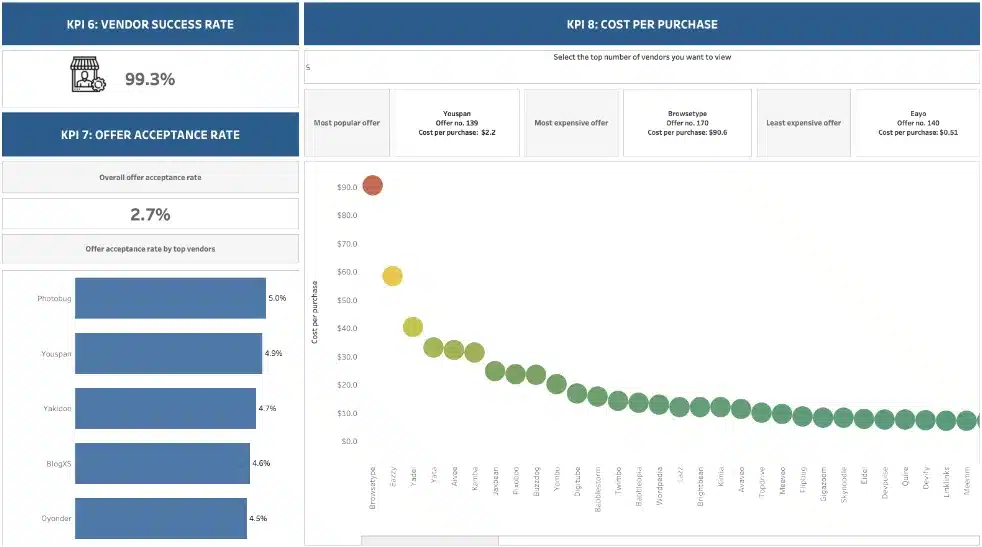Introduction
Data has become the lifeblood of decision-making, risk assessment, and strategic planning in today’s rapidly evolving financial landscape. Financial institutions increasingly turn to data warehousing solutions to effectively harness data’s power.
The significance of data management in the financial industry will be explored in this blog, highlighting the numerous benefits of implementing a financial data warehouse.
Benefits of a Financial Data Warehouse: Empowers Dynamic Dashboarding in Finance

Dashboards generated by a data warehouse play a crucial role in helping financial companies gain valuable insights. These visualizations provide a consolidated view of relevant economic data, enabling stakeholders to monitor key performance indicators (KPIs), track trends, and make informed decisions. The importance of a financial data warehouse lies in its ability to aggregate and integrate data from various sources, ensuring data accuracy, consistency, and accessibility, which are essential for creating meaningful dashboards.
Financial companies can use a data warehouse to create visually appealing and interactive dashboards that clearly and concisely present information. These dashboards can display real-time data, historical trends, and predictive analytics, allowing users to monitor business metrics, identify anomalies, and assess performance against goals.
Enhanced Data Integration and Consistency

Data Integration Challenges in Finance
In the financial sector, data integration poses significant challenges due to the diverse sources and formats of data. Financial institutions often have data spread across multiple sources, including core banking systems, transactional databases, customer relationship management (CRM) platforms, market data providers, and more.
These disparate data sources may use different data models, naming conventions, and formats, making it challenging to aggregate and analyze data effectively. Manual data integration processes are time-consuming, error-prone, and hinder access to a holistic view of financial data.
Role of Financial Data Warehouses
Data Warehouse plays a vital role in addressing the data integration challenges faced by financial institutions. Organizations can consolidate data from multiple sources by implementing a data warehouse solution, applying necessary transformations, and loading it into the data warehouse.
ETL processes can handle data cleansing, deduplication, data format conversions, and other necessary tasks to ensure data consistency and integrity. Additionally, data warehouse solutions often provide tools and functionalities for data mapping, quality management, and lineage tracking, further enhancing the integration process.
The benefits of data integration and consistency a data warehouse offers are manifold. Firstly, financial institutions can access a comprehensive and unified view of their data, enabling accurate data analysis and reporting. Decision-makers can confidently rely on consistent and reliable data to gain insights into customer behavior, identify trends, and make data-driven decisions.
Consolidated and integrated data also facilitate regulatory reporting and compliance. Financial institutions must provide accurate and timely reports to regulatory authorities. Data warehousing ensures that the required data is readily available, validated, and aligned with regulatory standards, reducing the risk of non-compliance and associated penalties.
Secondly, consistent and reliable data enables a better risk management process. Financial institutions can analyze historical data trends, identify potential risks, and implement proactive risk mitigation strategies.
By having a holistic view of data, organizations can make more informed decisions regarding investment strategies, credit risk assessments, and portfolio management.
Are you interested in knowing more about setting up a data warehouse for your company? Do not hesitate to reach out.
Improved Data Accessibility and Visibility
Challenges of Data Accessibility in Finance
Accessing and retrieving relevant data promptly can be a significant challenge in the finance industry. Financial institutions deal with vast amounts of data spread across multiple sources, making it difficult for employees to locate and extract the necessary data.
Siloed data, complex financial data structures, and inconsistent data formats further complicate the process. These challenges result in delays, inefficiencies, and hindered decision-making.
Role of Financial Data Warehouses in Data Accessibility
Data Warehouses address the challenges of data accessibility and retrieval by providing centralized and structured data usage. Data from multiple sources is transformed, cleansed, and organized within a data warehouse into a consistent and unified structure. This centralized repository acts as a single source of truth, enabling users to locate and retrieve the required data quickly.
Data warehouses often incorporate data modeling techniques, such as dimensional modeling or star schemas, to enhance data access. These models enable users to navigate and query data user-friendly and intuitively, simplifying data retrieval.
Additionally, data warehouses offer data indexing, partitioning, and optimization techniques that further improve data accessibility and retrieval speed.
The benefits of improved data accessibility and visibility provided by data warehousing in finance are significant. It enables faster and more efficient data analysis, eliminating the need for manual data extraction and enabling quicker decision-making.
Financial institutions can access relevant data easily, respond to market changes on time, and improve operational efficiency.
Data warehousing also enhances the ability to gain valuable insights from data. By providing a centralized and consistent view of data, comprehensive analysis becomes possible, enabling the identification of patterns and actionable insights.
These insights can be used to understand customer behavior, optimize product offerings, identify new market opportunities, and improve risk management strategies.
Moreover, data warehousing supports self-service analytics, allowing users across the organization to explore and analyze data independently. With intuitive querying tools and visualization capabilities, business analysts and data scientists can derive insights on-demand, reducing the reliance on IT teams and fostering a more data-driven culture within the organization.
Data Governance and Compliance

Overview of Regulatory Requirements in the Finance Industry
The finance industry operates in a heavily regulated environment to ensure consumer protection, maintain market integrity, and mitigate systemic risks.
Regulatory bodies impose stringent requirements on financial institutions, including banks, insurance companies, and investment firms. These requirements encompass areas such as data privacy, security, anti-money laundering (AML), know-your-customer (KYC) regulations, and financial reporting standards (like IFRS and GAAP).
Role of Data Warehousing in Ensuring Data Governance and Compliance
Data warehousing enables financial institutions to meet regulatory requirements and adhere to best practices in data governance. Organizations can implement robust data governance frameworks encompassing data quality, lineage, privacy, and security measures by centralizing data within a data warehouse.
Data warehousing facilitates the establishment of data governance policies and procedures, ensuring that data is appropriately managed throughout its lifecycle. Financial institutions can define and enforce data standards, access controls, and retention policies. Data warehousing solutions often incorporate data profiling and cleansing capabilities, helping identify and rectify financial data quality and consistency issues.
Maintaining data integrity, security, and auditability through data warehousing benefits financial institutions significantly. Firstly, it ensures accurate and reliable financial reporting by consolidating and validating data in a standardized format, reducing reporting errors, and enhancing transparency. This promotes compliance with regulatory reporting standards and instills trust in financial reports.
Data warehousing also enhances data security by centralizing control over data access. Implementing access controls, encryption mechanisms, and user authentication within the data warehouse environment safeguards sensitive financial information, protecting against unauthorized access, data breaches, and fraud. This mitigates potential reputational and financial risks for financial institutions.
Furthermore, modern data warehouses facilitate audibility by maintaining a comprehensive audit trail of data transformations, updates, and user activities. This audit trail supports regulatory compliance audits, internal audits, and investigations. Tracking data lineage, monitoring data changes, and demonstrating data integrity to regulatory authorities have become more manageable for financial institutions.
Enhanced Business Intelligence and Analytics

Importance of Data-Driven Insights in Finance
In the finance industry, data-driven insights are paramount for making informed decisions, optimizing performance, and gaining a competitive edge. Financial institutions deal with vast amounts of data, including market trends, customer behavior, transactional data, and economic indicators. Extracting meaningful insights from this data is crucial for risk management, forecasting, and strategic planning. Financial Data warehouses help financial companies derive powerful insights efficiently.
How Data Warehousing Enables Advanced Analytics and Business Intelligence
Data warehousing is pivotal in enabling advanced analytics and business intelligence in the finance industry. Data warehousing provides a unified and structured data environment that supports complex analytics by consolidating data from various sources into a central repository.
Data warehouse solutions offer powerful querying and analysis capabilities, such as online analytical processing (OLAP) and data mining, allowing financial institutions to perform multidimensional analysis, trend analysis, and predictive modeling. These analytical tools help uncover patterns and correlations within the data and track crucial economic indicators, leading to valuable insights and actionable intelligence.
Furthermore, data warehouse solutions often integrate with business intelligence (BI) tools and dashboards, enabling users to visualize data and create interactive reports. This empowers stakeholders across the organization to explore data, identify trends, and make data-driven decisions.
Leveraging data through a data warehouse offers numerous benefits for financial institutions in risk management, forecasting, and strategic planning. Data-driven risk management enables organizations to assess and mitigate various risks, such as credit, market, and operational risks. Historical data combined with predictive modeling can help identify potential risks, evaluate their impact, and develop effective risk mitigation strategies.
Forecasting is another critical aspect where data analytics proves invaluable. Financial institutions can create accurate forecasts for sales, revenue, market trends, and customer behavior by analyzing historical data trends. These forecasts aid in resource allocation, budgeting, and identifying growth opportunities.
Strategic planning also benefits from data-driven insights. Financial institutions can better understand market dynamics, customer preferences, and competitive landscapes by analyzing internal and external data. This enables them to make informed decisions regarding product development, market expansion, and investment strategies, fostering a proactive and competitive approach.
Any questions? Do not hesitate to reach out.
Scalability and Future-Proofing

Challenges of Managing Growing Volumes of Financial Data
Financial institutions face significant challenges in managing the ever-growing volumes of financial data. As the industry evolves and technology advances, the amount of data generated and collected increases exponentially. This surge in data poses challenges related to storage, processing power, and performance. Traditional data management approaches struggle to handle the scale and complexity of data, leading to limitations in data accessibility, processing speed, and overall system performance.
Role of Data Warehousing in Accommodating Scalability
Data warehousing is crucial in accommodating scalability and future data growth for financial institutions. With its architecture designed to handle large volumes of data, data warehousing provides a scalable solution to store and process vast amounts of financial data efficiently.
Scalable data warehousing solutions employ partitioning, clustering, and parallel processing techniques to distribute data across multiple servers, enabling parallel execution of queries and increasing processing speed. These capabilities allow financial institutions to scale their data infrastructure seamlessly as data volumes grow. Data warehousing solutions can also leverage cloud-based data warehouse technologies, providing elastic scalability by dynamically allocating resources based on demand.
By adopting a data warehousing approach, financial institutions can future-proof their data infrastructure, ensuring it can handle the increasing demands of data growth. This scalability allows organizations to scale up or down as needed, supporting their long-term finance seamless data management requirements.
A scalable data infrastructure offers several benefits for financial institutions’ long-term success. Firstly, scalability enables organizations to handle growing data volumes without compromising performance. As data volumes increase, financial institutions can continue to access, analyze, and derive insights from their data on time. This supports data-driven decision-making, ensuring that critical data insights are available when needed.
Scalability also provides flexibility and agility in adapting to changing business needs. Financial institutions can easily accommodate new data sources, integrate different systems, and support emerging technologies. This adaptability allows organizations to leverage innovative solutions, explore new business opportunities, and stay ahead of market trends.
Furthermore, a scalable data infrastructure enhances operational efficiency and cost-effectiveness. By leveraging distributed processing capabilities, financial institutions can achieve faster query response times, optimize resource utilization, and reduce the need for extensive hardware investments. This improves the overall data processing efficiency, enabling organizations to extract value from their data more effectively.
How Can Data-Sleek Help?
Undoubtedly, the finance industry will continue to reap the rewards of this excellent tech tool in the future. These six benefits can make a big difference in effective financial operations. Data warehousing allows finance teams to have greater confidence in their decisions. Also, it enables them to work smarter instead of harder when completing tasks.
At Data Sleek, we help you execute critical projects with ease. We provide comprehensive data warehouse consulting services, asset maintenance, and scalability enhancements. Our tailor-made solutions can help you grow your business and improve performance.
Book a free consultation with us today if you want a modern and efficient data warehouse implementation.







